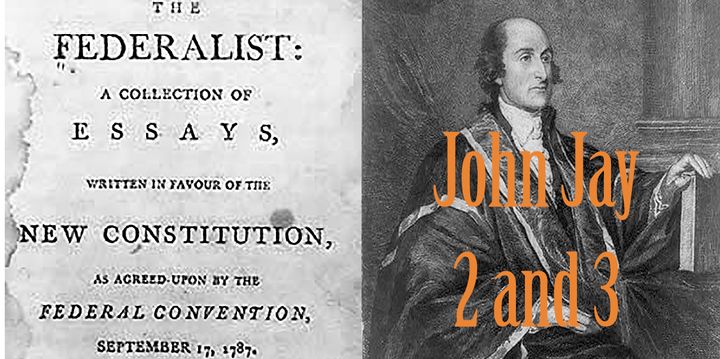
John Jay, coauthor of the Federalist Papers
On January 20, at noon, Donald Trump will take the Presidential oath to “…the best of my ability, preserve, protect and defend the Constitution of the United States.” There are many Americans who wonder whether Mr. Trump will fully grasp the import of that swearing-in moment. If the examples of Mr. Trump’s actions since the election—his constant Tweeting, and using Twitter on New Year’s Day to snipe at his former challengers and to demean, in rude terms, those Americans who did not vote for him—are accurate indices, there will be no such comprehension.
I have suggested frequently that Mr. Trump could find foundation-firm guiding principles within the nation’s original blog, the Federalist Papers. He should put down his phone for more than a few minutes and read Alexander Hamilton’s, James Madison’s, and John Jay’s 18th century posts, if he wishes to avoid the procedural, political, cultural, and international pitfalls that lie along the path of his impending presidency.
In my prior post, I highlighted Hamilton’s concerns in Federalist 1, about the “features and forces which may not be in the best interests of the nation’s future success, and which must be viewed critically despite personal, financial, or political affections.” I questioned the characters and the qualifications of the (mostly) (white) (wealthy) men Mr. Trump has put forward to lead the Cabinet and sub-Cabinet departments and agencies under his executive control. Any bold text is mine for editorial emphasis.
In Federalists 2 and 3, John Jay talks about the rectitude of honoring treaties and other international commitments as one nation, and not as a nation divided by a multitude of regional or local sympathies. In the second paragraph of Federalist 2, Jay writes,
Nothing is more certain than the indispensable necessity of government, and it is equally undeniable, that whenever and however it is instituted, the people must cede to it some of their natural rights in order to vest it with requisite powers. It is well worthy of consideration therefore, whether it would conduce more to the interest of the people of America that they should, to all general purposes, be one nation, under one federal government, or that they should divide themselves into separate confederacies, and give to the head of each the same kind of powers which they are advised to place in one national government.
At the time of the Federalist Papers, the Articles of Confederation had failed to promote a unified national voice and coherent mission. Jay and his coauthors were writing specifically about the importance of creating a Constitution that would do just that. A Constitution which would allow America’s leaders to speak for all the people of the new United States. This is a particularly evergreen command to be carried out unfailingly by the man or woman who sits in the Oval Office. To speak obliquely to the public, to be unclear in messaging our nation’s affections as well as our nation’s skepticism to the world of nations, is to risk the most dangerous results of misinterpretation.
In Federalist 3, Jay lays out reasons for unity in the name of national security. He writes,
The just causes of war, for the most part, arise either from violation of treaties or from direct violence. America has already formed treaties with no less than six foreign nations, and all of them, except Prussia, are maritime, and therefore able to annoy and injure us. She has also extensive commerce with Portugal, Spain, and Britain, and, with respect to the two latter, has, in addition, the circumstance of neighborhood to attend to.
The intervening two centuries have seen additions and name changes to the list of nations with whom the U.S. shares commerce, peace, and protection. It is crucial that we adjust to the realities of new trade models, reshaped borders, and alliances unsuspected in the days of the Founders. And yet, the incoming president has so far demonstrated an unsettling, if not frightening lack of understanding of the dynamics of international cooperation, compromise, and trust. And he has, so far, exhibited no qualms about poking the nests of nations whose sole goal is to annoy and injure us. As if seeing clearly a future Trump, Jay writes,
It is of high importance to the peace of America that she observe the laws of nations towards all these powers, and to me it appears evident that this will be more perfectly and punctually done by one national government than it could be either by thirteen separate States or by three or four distinct confederacies.
Long before his Twitter addiction would cause Donald Trump’s fingers to unilaterally formulate and communicate national policy in 140 characters (prior to his actual assumption of office), the authors of the Federalist Papers sought to tamp down the likelihood of one or more confederated states dealing independently with America’s trading partners and potential enemies.
By pitting social classes against each other as he did during the presidential campaign, by speaking publicly and ignorantly about Russian espionage, by taunting Beijing by talking to the Taiwanese leadership in contravention of decades of carefully-maintained protocols, and by presuming to preempt the Constitutional duties of a sitting president, Trump acts in no less a capacity as a 21st century separatist confederate as did those 18th century advocates for state autonomy of whom Jay warned.
Trump is just as surely creating division within the country as a whole as if he were to advocate for any state to secede from the union. When Trump Tweets to his chosen audience, he is creating and encouraging dissatisfaction, dissension, and distrust among factions within our society. Trump’s actions in 2017 echo the calls of the selfish factions fomenting separation of the 13 states uneasily connected in 1787 by the failed Articles of Confederation. If Trump’s goal is to divide and conquer, he must first scale the wall of the Constitution…and that, as we see in the Federalist Papers, is a high wall indeed.
To be continued.
